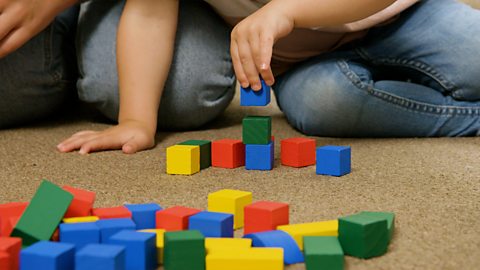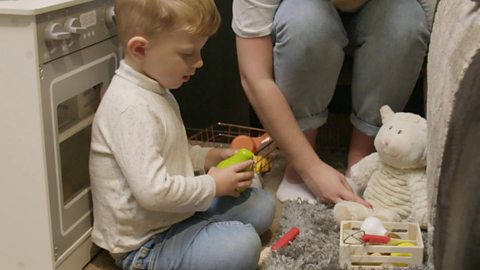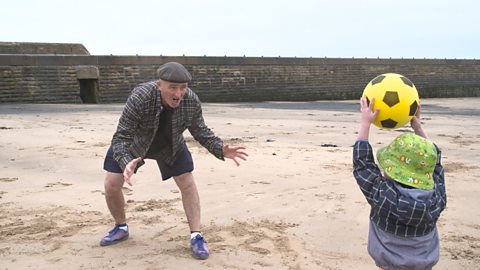Your child might have been playing with building blocks since they could sit up, reach and grab objects. But how can you make sure this activity still challenges them as they get older?
This activity is a great example of using your building blocks in a new way to expand your child's vocabulary and teach patience and resilience.
Watch the video below to see how building towers against the clock with your child is a great opportunity to chat to them all about their perseverance and hard work.
We're going to build a big tower and we have to do it as fast as we can.Ten, nine, eight, seven, six, fiveβ¦
Oh!It falled!
What happened?
It falled!
It fell again? That's alrightβ¦Let's try it again, look. Maybe if you do it a little bit slower, then it might balance a little bit better. What do you think?
Aha.Ten, nine, eight, seven, sixβ¦
Ah! It falled again.
Did it fall down again?
Yeahβ¦How do you feel when these blocks fall down, Chase?
A little bit sad.
Why do you feel a little bit sad?
Because I can't build them up. What are we going to do?
We will do it another time. I think if we try one more time, and maybe we'll take two blocks away, then that might help to build it. What do you think?
Aha.
You ready? On your marks, get setβ¦Go!Ten, nine, eight, sevenβ¦Keep going! Six, five, four, three, two, oneβ¦
I did it!
How do you feel now?
Yeah, that makes me happy!
That makes you happy? Why are you happy?
Because I built it myself!
That's amazing.
What are the benefits of building blocks against the clock?
- This game helps children learn how to describe the properties and positions of items.
- When the tower falls, the game allows you to chat about your child's emotions and feelings.
- It's a great opportunity to explain that things might not always go right at first.
- By chatting together about how they could build a better tower, you're teaching them about hard work and perseverance.
- Using building blocks helps boost fine and gross motor skills and hand-to-eye coordination.
Top tips for building blocks against the clock
Ask your child to build the tallest tower they can in 10 seconds. Can they build a tall tower without knocking it over accidentally?
Depending on your blocks, you might want to extend the time to 20 seconds or even a minute. Make a decision based on their ability.
If you want to add a level of difficulty, ask them to count the blocks as they're building. If they are a confident builder, why not have a race? Who can build the tallest tower in 10 seconds?
The time pressure might make them panic and knock over their tower. If this happens, encourage them to try again and praise them for their efforts.
It is a great chance to introduce words, like tall, short, tower, building, fall. You can also add more complex words, which will help with their maths language when they get to school.
Try introducing words like longer, shorter, taller, longest, tallest, shortest and concepts of first and last.

5 more block activities to boost language
1. Block sorting and matching
Ask your child to find all the red blocks, for example, and put them in a separate pile or a special place.
Start with asking them to find just one colour and, as they develop their skills, build up to sorting all of the blocks at once.
2. Block bowling
Make sure to try this game in a safe space, where nothing will be damaged if blocks fall over.
Use a soft toy or a ball of socks to knock down your block towers. You can encourage listening skills by making them wait for you to say "ready, steadyβ¦.go".
3. Block treasure hunt
Hide some blocks around the room or house and give them simple clues to help find them.
If the blocks are different colours, you could hide the red block near another red item in the room. Include the colour red in your clues.
4. A twist on tower building
Instead of asking them to build the tallest tower, why not see if they can build the most colourful, most creative or prettiest tower?
This is a great way to introduce different superlatives into your child's vocabulary.
5. Introduction to measuring
You can use blocks to help improve their number skills. Instead of stacking them up high, why not line them up on the floor and use them to "measure" how tall their other toys are?
Lie a teddy bear or another toy next to the line of blocks and ask your child, "how many blocks tall is teddy?"
Find out more about the benefits of building blocks for toddlers & preschoolers.







